Expert’s Rating
Pros
- Functional design with included hood, remote
- Extensive image quality customization
- Excellent color performance
- Paper-like “fine-coated panel”
Cons
- Disappointing contrast
- Modest downstream USB-C connectivity
- Only 2560×1440 resolution
Our Verdict
The BenQ SW272Q is a standout monitor for photographers, videographers, and other professionals who need excellent color accuracy and extensive image quality customization.
Price When Reviewed
$799.99
Best Prices Today: BenQ SW272Q
$799.99
Today’s most alluring monitors, like the new QD-OLED, high-refresh displays monitors at CES 2024, are built for entertainment first. The BenQ SW272Q is different. It’s a professional monitor designed for people who create or edit photos, images, and documents. The SW272Q’s complete focus on work makes it a niche display, but it fills that niche well.
Further reading: See our roundup of the best home office monitors to learn about competing products.
What are the BenQ SW272Q’s specs and features?
At a glance, the BenQ SW272Q’s specifications are typical for dozens of mid-range monitors. It has a 27-inch panel with 1440p resolution and a 60Hz refresh rate. HDR is supported, but the monitor isn’t VESA DisplayHDR certified. USB-C with video and power delivery is available but downstream connectivity is limited to a couple USB-A ports and an SD card reader.
- Display size: 27-inch widescreen
- Native resolution: 2560×1440
- Panel type: IPS “fine-coated panel”
- Refresh rate: 60Hz
- Adaptive sync: None
- HDR: Yes, HDR10
- Ports: 2x HDMI 2.0, 1x DisplayPort 1.4, 1x USB-C with DisplayPort Alternate Mode and 90 Watts Power Delivery, 1x USB-B upstream, 2x USB-A 3.1 downstream, 3.5mm audio-out
- VESA mount: 100x100mm
- Speakers: None
- Price: $799.99 MSRP
Which begs the question: Why is this monitor $800? There are several reasons for it, as I’ll explain, and they define who this monitor is for.
How is the BenQ SW272Q’s design?
BenQ SW272Q (backside).
Matt Smith
The BenQ SW272Q ditches the slim, svelte design of consumer displays for a boxy, industrial look. Slim bezels remain on the sides and top, but the bottom bezel is chunky, and the display panel is thick (though not unusually heavy).
That doesn’t sound impressive. And yet, the SW272Q struck me as attractive. The monitor’s materials have a pleasant texture that looks more expensive than the toy-like plastic found on some. The monitor’s girth also adds a utilitarian flair.
BenQ ships the monitor with an extraordinarily sturdy ergonomic stand that adjusts for height, swivel, tilt, and can pivot 90 degrees for use in landscape orientation. It includes up to 140mm of height adjustment and 60 degrees of swivel, which is a bit more than usual (I’d say 110mm of height and 20 to 40 degrees of swivel is typical). A 100x100mm VESA mount is included for use with a third-party monitor stand or arm.
Further reading: The best monitor arms
The monitor stand’s base is large, which is normally a problem, but BenQ turns it into an advantage. It keeps the base slim, at just a few millimeters thick, and coats the majority in a grippy leatherette, which adds to the monitor’s luxury feel and provides a good place to rest a notepad or smartphone.
BenQ also includes a hood that snaps over the display and reduces the amount of ambient light that hits the display. The hood has a trap door that makes it possible to use a monitor calibration tool while the hood is installed. It looks a bit clunky, but it’s easy to assemble and does the job.
How is the BenQ SW272Q’s connectivity and menu?

The BenQ SW272Q’s connectivity features.
Matt Smith
BenQ delivers acceptable but typical connectivity for a monitor in its price range. It includes two HDMI 2.0, one DisplayPort 1.4, and one USB-C with DisplayPort 1.4 and 90 watts of USB Power Delivery. That’s a good range of video input that can handle a wide range of devices, from tablets and laptops to desktop PCs and streaming sticks.
Downstream USB connectivity is a bit lacking, with just two downstream USB-A ports, but these are paired with a rare feature useful for the SW272Q’s intended audience: an SD card reader. I can’t remember the last time I saw a monitor with a built-in reader, but it’s undeniably useful for photographers or videographers.
The monitor also has a USB-B upstream port, which can drive the USB-A ports if your computer lacks USB-C, and a 3.5mm audio-out jack.
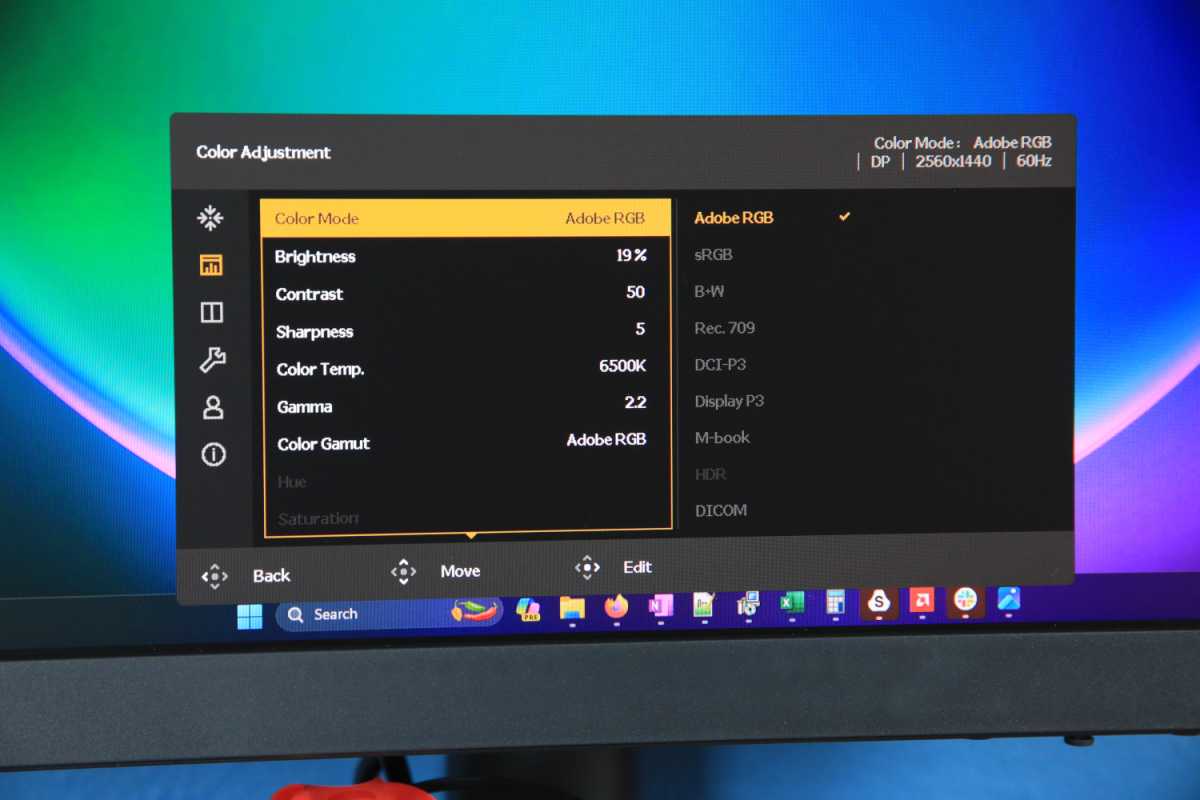
The BenQ SW272Q offers an extensive menu system with tons of image quality configuration options.
Matt Smith
The SW272Q’s on-screen menus can be controlled through a joystick on the bottom bezel, which is true of most monitors, or through BenQ’s wireless Hotkey Puck G3. The puck is a small wireless controller that can access all the monitor’s options. It’s quicker, more intuitive, and more comfortable than the joystick, which isn’t bad, either.
Monitor customization is extensive, and BenQ’s on-screen menus are excellent. The menus look attractive, respond immediately, and are packed with useful options. The monitor has precise options for both color temperature and gamma (meaning they use specific numerical values, not vague labels like “Warm” or “Gamma 1”). It also has preset modes for the sRGB, DCI-P3, AdobeRGB, and Rec. 709, Display P3, and DICOM color standards.
I can’t remember the last time I saw a monitor with a built-in SD card reader, but it’s undeniably useful for photographers or videographers.
And that’s just the tip of the iceberg. BenQ’s options are so extensive that they frankly tax even my ability to evaluate them, despite the fact I review dozens of monitors each year, as many of the monitor’s options and features target professionals working on projects that demand color performance calibration to stringent standards.
The monitor comes with a one-year subscription to Pantone’s Connect Premium mobile app, for example, and can be used with a BenQ app called Paper Color Sync, which is designed to match the monitor’s appearance to a particular type of paper.
In truth, most people won’t need such features. I’m something of a photographer and videographer myself, since I take photos for these reviews, but the SW272Q’s feature set targets the upper echelons of color-critical work. It’s meant for people who create photos or art for print and want their monitor to appear as close to the final result as possible, and it has the image quality customization needed to support that.
How is the BenQ SW272Q’s SDR image quality?
Image quality is obviously key for the BenQ SW272Q, but the particulars of what it’s trying to achieve differ from most consumer monitors. This leads to advantages, and disadvantages, that have a big impact on how the monitor looks in both day-to-day and professional use.
The results below measure the default color mode (Adobe RGB).
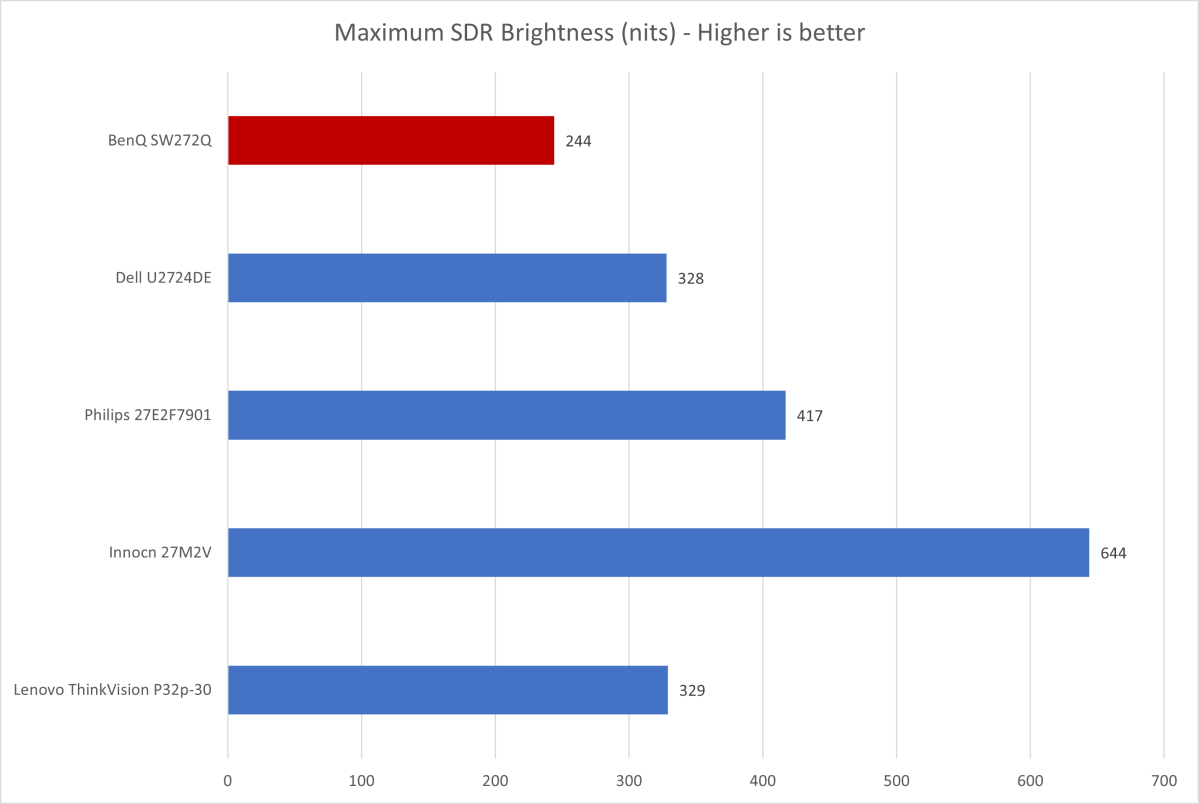
Matt Smith
We start off with brightness, where the SW272Q achieves a rather low maximum brightness of 244 nits in HDR. That’s not high for a modern monitor, and it implies the monitor could be less than ideal for use in a bright room without light control.
But that’s not much of a surprise. The BenQ SW272Q is explicitly meant to be used in a room with light control, and the included hood further reduces glare and the intrusion of ambient light. It also has an effective anti-glare coating. Because of this, the monitor appears rather bright in most situations.
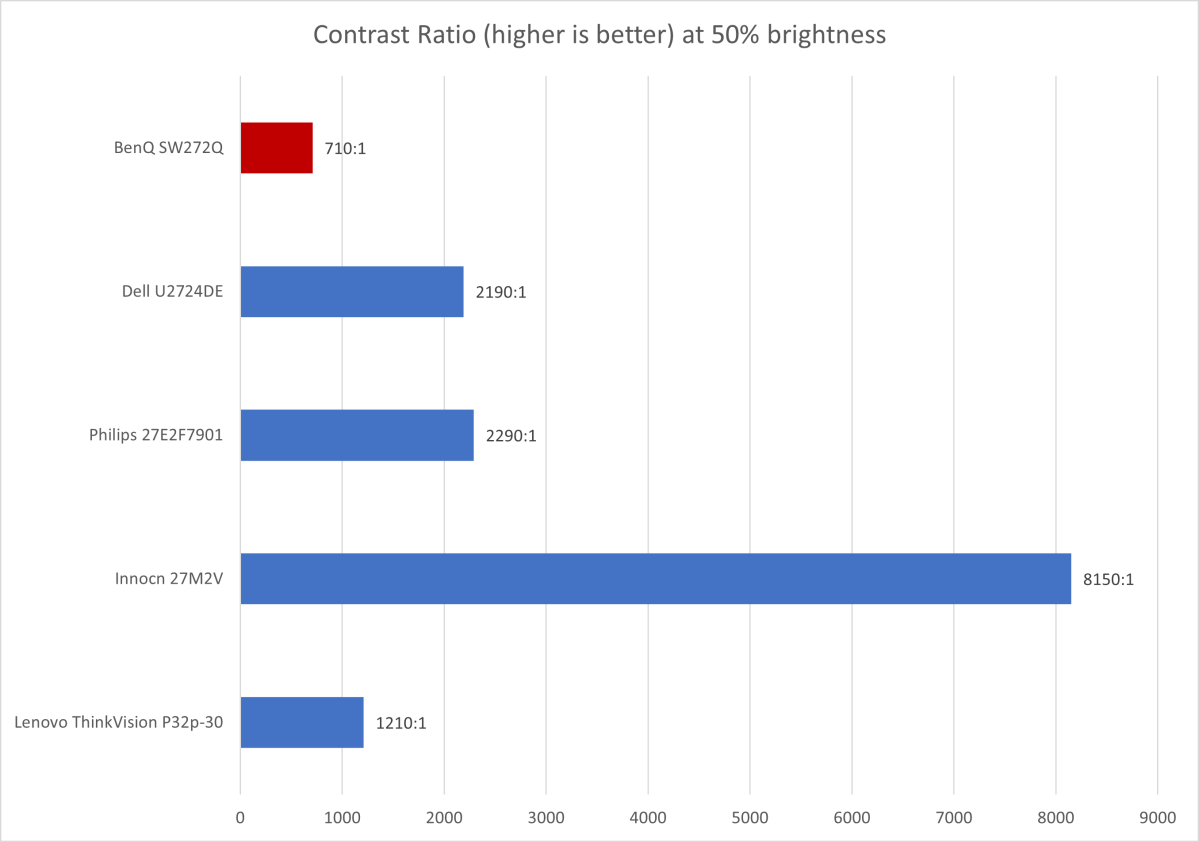
Matt Smith
I recorded a maximum contrast ratio of 710:1 in SDR which, like the SW272Q’s brightness, is rather low. But unlike its brightness, which isn’t an issue in real-world use, the monitor’s contrast noticeably degrades its image quality. The SW272Q shows significant “IPS glow,” an issue that causes scenes which should be pitch black to instead appear as a foggy, hazy gray.
This is an important test that should give those who don’t need the SW272Q’s advanced features pause. Innocn’s 27M2V Mini-LED monitor, which is priced competitively with the SW272Q, delivers a better sense of depth, immersion, and realism. The SW272Q looks flat and washed-out by comparison.
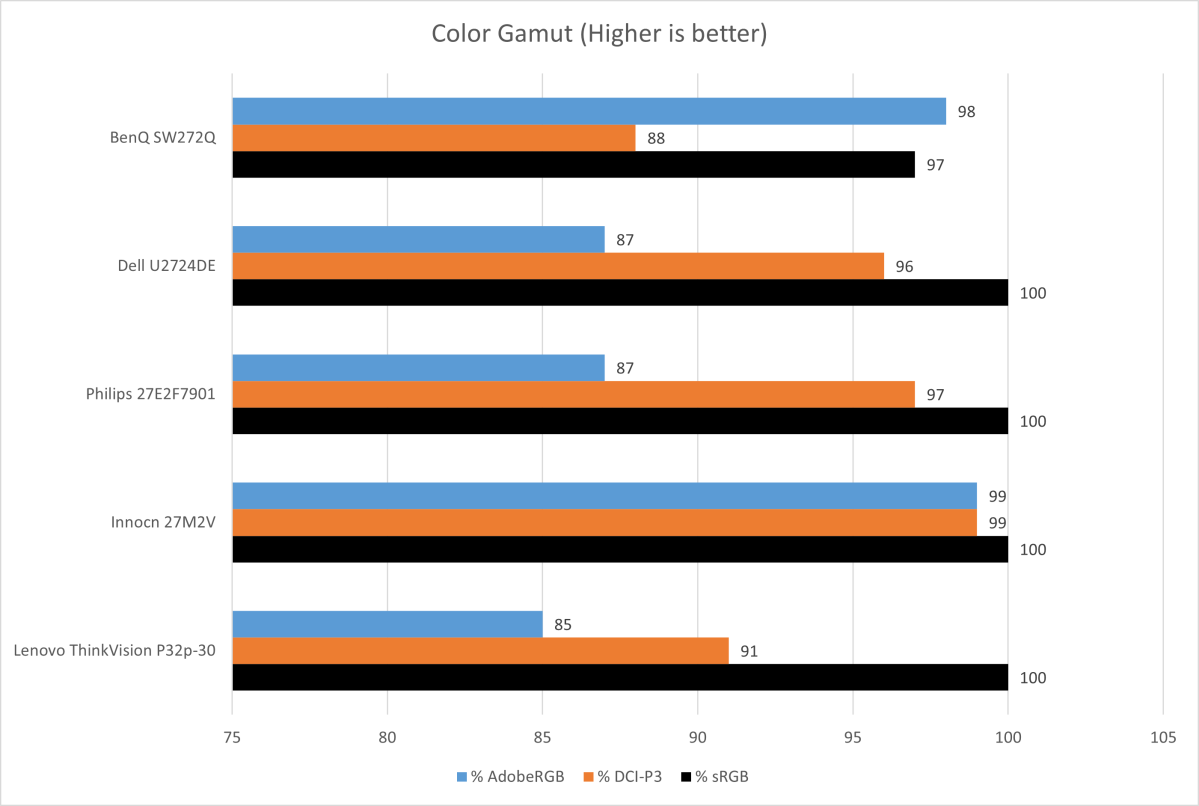
Matt Smith
The SW272Q’s color gamut performance again demands some discussion. It achieves up to 98 percent of the AdobeRGB color gamut, up to 99 percent of sRGB, and up to 94 percent of DCI-P3, but not all three at the same time.
This is both an advantage and a disadvantage. Tightly controlling the color gamut can prove useful for professionals who work within a specific color gamut. In general use, however, the SW272Q’s color gamut might appear a bit less vibrant than some alternatives.
Unlike contrast, however, this is a nitpick. The SW272Q’s color performance in its Adobe RGB and Custom color modes, which in my testing were the widest overall, is still more than enough to deliver a vibrant, punchy image.
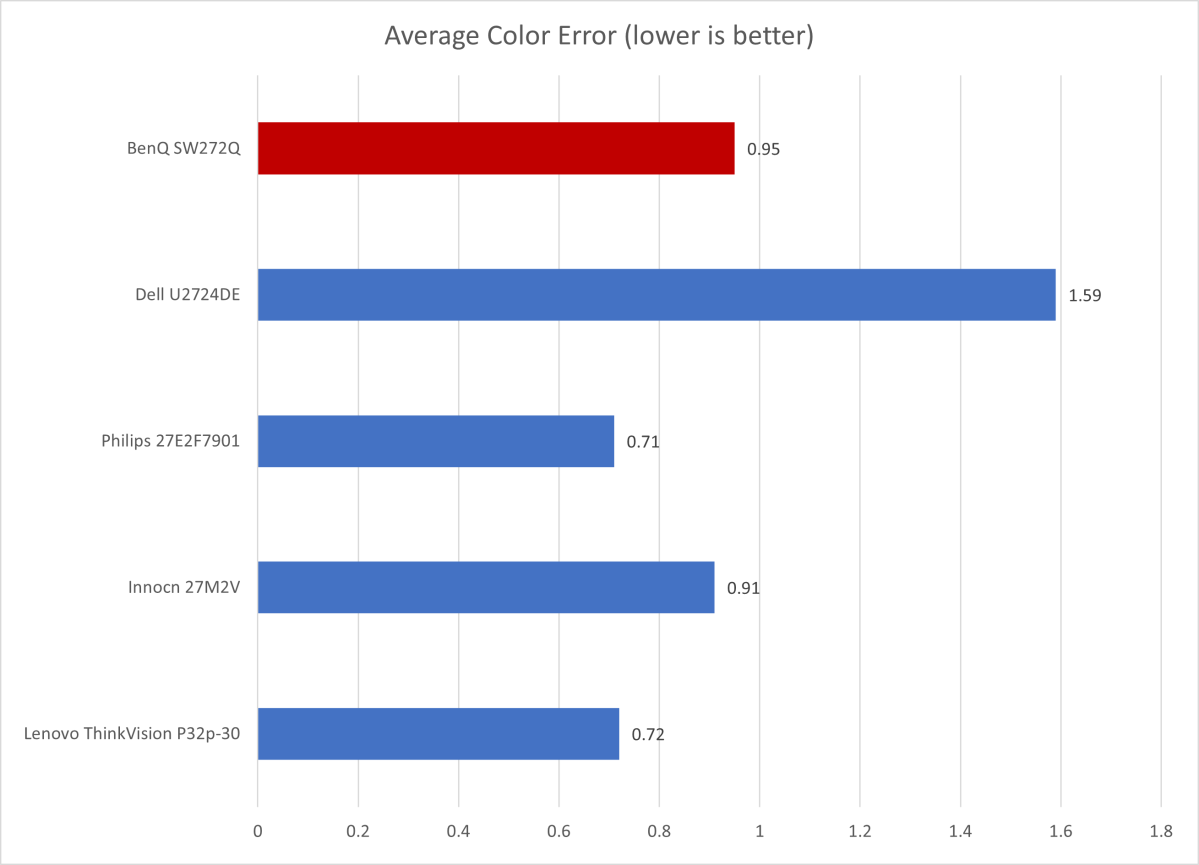
Matt Smith
Next up is color accuracy, where the SW272Q’s performance is good, but not unusually so for a modern monitor. An average color error below two is generally not an issue, and an error below one is excellent for both casual and professional use.
With that said, remember that the SW272Q’s on-screen menus provide customization not found on most monitors. That’s important, as it means you can tune the color performance to meet your specific needs, which can vary greatly depending on where your work will be viewed.
The SW272Q scored well in color temperature and gamma, as it achieved a default color temperature of 6200K (slightly below the target of 6500K) and an on-target gamma curve of 2.2. The default image quality was ever-so-slightly warmer than my target, but otherwise on point. Again, the range of options is important: The SW272Q supports color temperature adjustment in increments of 100 between 5000K and 9300K, as well as gamma curve settings between 1.6 and 2.6.
All of this is well beyond what an average home office user needs, and more than typical even from high-end productivity monitors like the Dell U2724DE, yet critical for people who need maximum control over their monitor.
Sharpness is good, but not excellent, as the monitor has a display resolution of 2560×1440. That works out to 109 pixels per inch. Images and video tend to look sharp, but will seem soft if placed next to a 4K display, and small fonts can look pixelated. 1440p resolution also makes the SW272Q a bad choice for editing 4K video or very high-resolution photos. BenQ offers a high-end version of the SW272Q, the SW272U, with a 4K panel, but it’s twice the price.
There’s one final X-factor: the SW272Q’s “fine-coated panel.” It’s a matte panel finish designed to minimize screen reflection and simulate the texture of a printed page. And it works. I immediately noticed a difference in the reflectivity of the display, which does in fact make photos, and even Word documents, look more like a printed page. It’s most useful for photographers, but writers, editors, and publishers who have strong opinions on the type of paper and font used by a book or magazine should also like what they see.
The BenQ SW272Q’s SDR image quality is excellent for its niche but not well-suited for everyday use and entertainment. Alternative monitors like the Dell U2724DE and Innocn 27M2V provide better image quality at a similar, or lower, price point. However, professionals who want an extremely accurate, customizable image will prefer the BenQ.
How is the BenQ SW272Q’s HDR image quality?

Lacking good HDR, the BenQ SW272Q is more suited for still image editing rather than video editing work.
Matt Smith
HDR is available on the BenQ SW272Q, but it lacks VESA DisplayHDR certification, and its HDR performance isn’t great.
I measured a maximum HDR brightness of 343 nits and a contrast ratio of 900:1. Both are improvements over SDR, but far short of what’s required for a good HDR experience.
That might be a surprise, given the SW272Q’s price, but it fits within the monitor’s niche. Although it can be used by videographers, it’s more firmly focused on still images and print, where HDR is less important.
How is the BenQ SW272Q’s motion performance?
The BenQ SW272Q is a 60Hz monitor with a quoted gray-to-gray response time of 5 milliseconds. It also lacks adaptive sync, so it’s not compatible with AMD FreeSync or Nvidia G-Sync.
That’s not great news for gamers. Motion blur is a common companion and can leave competitive players at a significant disadvantage in multiplayer titles. The lack of adaptive sync is also sorely felt. You’ll have to rely on V-Sync, which can sometimes lead to stutter, or put up with screen tearing.
None of this is a surprise. The SW272Q is not meant for gaming or entertainment. However, I’m increasingly reluctant to give even professional monitors a pass on refresh rate. A 120Hz refresh rate can make a PC feel more responsive even on the Windows desktop, and I suspect those keen-eyed enough to care about the SW272Q’s nuanced image quality might also care about its refresh rate.
To be fair, the majority of BenQ’s competitors also stick to 60Hz. But there are some exceptions, most notably in Asus’ ProArt and Dell Ultrasharp monitors, where refresh rates of 75Hz to 120Hz are becoming common.
Is the BenQ SW272Q worth it?
The BenQ SW272Q is a great monitor for people with specific needs. It provides a wide range of customization, which is easy to access through the included wireless puck, alongside a “fine-coated panel” that mimics the look of paper. The monitor also scores well in color gamut and accuracy. It suffers a mediocre contrast ratio, however, and it lacks the sharpness, HDR performance, and motion clarity a typical home user should expect from a monitor with a $799.99 price tag. The SW272Q is a very good monitor for a very specific audience.



